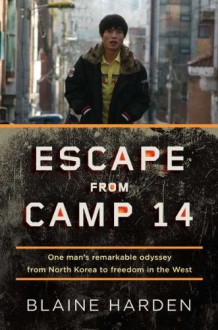
Shin Dong-Hyuk grew up not knowing that there were other children in other places who were did not have to learn to catch and roast rats in order to keep from starving, or who were not subjected to endless hours of labor while watching for errant behavior of peers to be reported immediately in a sort of sacred duty of snitching. Such other children, however, were not born and raised completely isolated from the rest of society in the confines of Camp 14- an internment camp in the totalitarian state of North Korea reserved for those designated as "unredeemable," a status passed down through three generations to atone for the sin of defection from or speaking out against the North Korean government.
This is book gives us an unprecedented look into the North Korean "gulags." Likewise, it is the story of what happens to a child raised in an environment without hope- one in which a child could dutifully report the overheard escape plans of his mother and brother to an on-duty guard and be filled with anger toward his mother as he watched her be hanged as she, and everyone in the camp, were made constantly aware that, even after their death, the families of attempted escapees would be tortured (as happened with Shin). The image (below) is from the film adaptation of his story, Camp 14 Total Control Zone, done for the Human Rights Watch Film Festival.

Shin's ultimate escape (not a spoiler in my mind, as it's in the title) thrusts him into a world of irreconcilable contradictions, one to which he and the rare other escapees are often ill-equipped to adapt.
I came across two interesting collections of images- one a set of North Korean propaganda posters called "Poster Children of the Hermit Kingdom," and the latter a series of drawings done by a defectors from North Korean prisons, and thought their juxtaposition might be of interest.


While journalist/author, Blaine Harden, satisfactorily explores the disorienting and continuing culture shock that has resulted in some dissatisfaction among aid workers with a portion of North Korean refugees, I found myself wanting a bit more political and historical context than was within his intended scope (the book is a breezy 200 pages). I commend him for bringing to light (and to the masses) an ongoing crisis that it is all too easy to ignore. While I am certainly five stars worth of horrified, it wasn't the most compelling read for me- though certainly not a waste of time given its length.
Image notes:
[1] Source: Unseen Films
[2] Kim Jong Il comforts a distraught nation after his father's death on July 8, 1994. In the background is the 66-foot bronze statue of the Great Leader that was erected on Mansu Hill in Pyongyang in 1972. Dark skies in depictions of this period symbolize the growing threat from without. Source: Poster Children of the Hermit Kingdom
[3] A drawing portrays torture inside North Korean prisons. The caption reads "Pigeon position interrogation." (Kim Kwang-Il/United Nations) Source: North Korea's Horrors As Shown By One Defector's Drawings


 Log in with Facebook
Log in with Facebook 












